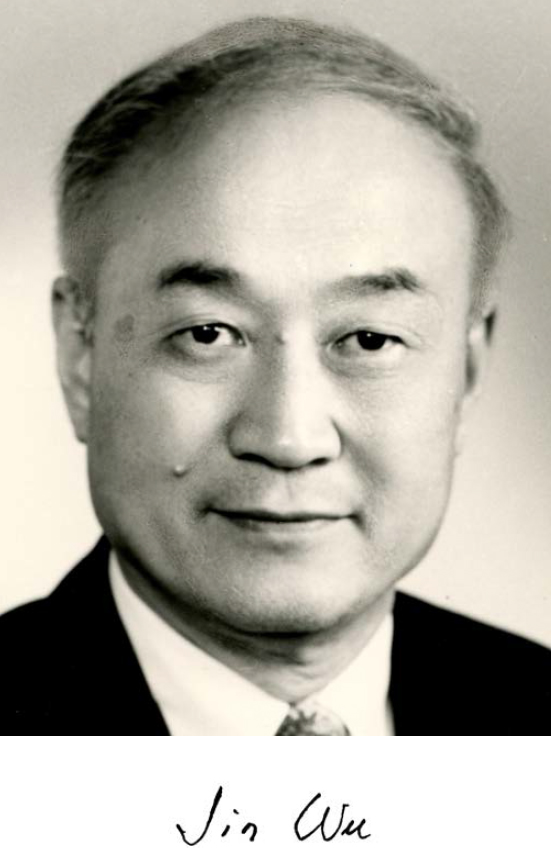JIN WU
1934–2008
Elected in 1995
“For advancing knowledge of the air-sea interface through experiments with applications to remote sensing and the environment.”
BY MARSHALL P. TULIN
JIN WU, a well-known engineering educator and experimental scientist specializing in air-sea interactions and the small-scale structure of the sea surface, died January 14, 2008, at age 74 in Tainan, Taiwan.
He was born in Nanjing, China, on April 9, 1934. In 1956 he graduated with a degree in civil engineering from National Cheng Kung University in Tainan, one of Taiwan’s largest and most important engineering schools, and later served as its president (1994–1998). He was also Taiwan’s Minister of Education (1996–1998) before returning to teaching at Cheng Kung, where he retired in 2004.
Professor Wu spent the largest part of his engineering life in the United States, beginning with graduate work (MS 1961, PhD 1964) at the University of Iowa’s Hydraulic Research Institute, then led by the well-known engineering educator Hunter Rouse. His doctoral research, under the supervision of Louis Landweber, was an experimental validation of Tulin’s wake survey method for the measurement of the viscous resistance of ship hulls.
Upon completing his studies, Jin began a career as a research scientist at Hydronautics, Inc., where he initiated a variety of laboratory studies of hydrodynamic phenomena, many in collaboration with the author. These included wake collapse
and internal wave generation in stratified media, drag reduction and turbulent diffusion in polymer solution flows, wave-current interactions, pollutant dispersion in streams, turbulent vortex pairs, wind stress, sea surface roughness, and air-sea interactions. The experimental studies of wave-current and wind-sea interactions were carried out in a 40-ft-long wind-wave tank that he built, the first large facility of its kind in the United States, accompanied by a variety of innovative instrumentation for the observation and measurement of the wind-generated sea surface.
In 1974 he began research and teaching in marine studies and civil engineering at the University of Delaware (at Newark) and eventually at a new marine site in Lewes, where he built the Air-Sea Interaction Laboratory. This important structure featured a large, advanced wind-wave tank in which he extended his earlier studies of the air-sea interaction to the atmospheric boundary layer, wave breaking, whitecaps, spray, surface films, bubbles, aerosols, sea salt, heat and mass transfer at the surface, rain-wave interactions, radar returns, and remote sensing of the sea surface.
Professor Wu played a major role in the development of marine studies and research at the University of Delaware, especially at Lewes, from which he retired as the H. Fletcher Brown Professor of Marine Studies and Civil Engineering.
He wrote and published extensively. His last publication, his 136th, was an article on “Small-Scale Wave Breaking: A Widespread Sea Surface Phenomenon and Its Consequence for Air-Sea Exchanges” (Journal of Physical Oceanography 25:3, March 1995).
His research at both Hydronautics and the University of Delaware had long been of great interest to, and supported by, the US Navy, and in 1991 he was appointed an Ocean Science Educator by the Office of Naval Research.
Throughout his life he maintained a close and supportive relationship with his alma mater, National Cheng Kung University, and in 1994 he returned there as its president. Higher education had always been heavily supported by the
national government, and during his term Cheng Kung continued the expansion of its large engineering campus.
In 1996 he was appointed Taiwan’s Minister of Education. In this role, he said, he “had tried to create an educational system that would provide young people with many choices and hope.” Too, he had favored, controversially, increased interchanges between Mainland and Taiwanese students.
In 1998 he returned to teach at Cheng Kung until he retired in 2004, after which he divided his time between Taiwan and his home in Rockville, Maryland. In his retirement he became fascinated with the life and world-spanning marine voyages of the early Chinese Admiral Zheng and was a visiting scholar at the Library of Congress at the time of his death. He was also in the midst of helping China’s Hong Zhou University plan a large hydrodynamics laboratory.
He served on many advisory committees here and abroad.
He is survived by his wife Tzu-Chen of Thousand Oaks, California; sons Victor Hua-Teh Wu also of Thousand Oaks, Abraham Hua-Chung Wu of Los Angeles, and Marvin Hua-Wei Wu of Chapel Hill; brothers Hai Wu of Shanghai and Yu Wu of Taipei; and four grandchildren. He and Tzu-Chen passed their interests in science, education, politics, history, and sports on to their children and grandchildren.






